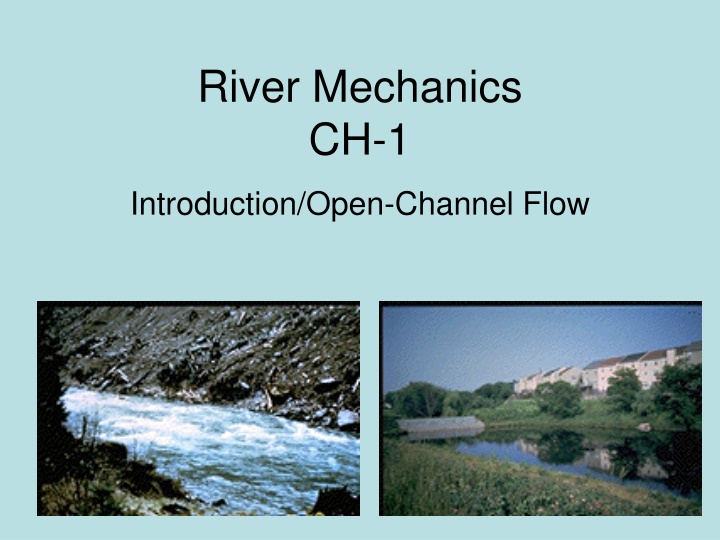
River Mechanics and Sediment Transport in Open Channels
Explore the complexities of sediment transport and open-channel flow in river mechanics, including insights from Albert Einstein's son and innovative approaches by researchers. Learn about natural and artificial channels, types of channels, and key geometric elements essential for a deeper understanding of hydraulic theory.
Download Presentation

Please find below an Image/Link to download the presentation.
The content on the website is provided AS IS for your information and personal use only. It may not be sold, licensed, or shared on other websites without obtaining consent from the author. If you encounter any issues during the download, it is possible that the publisher has removed the file from their server.
You are allowed to download the files provided on this website for personal or commercial use, subject to the condition that they are used lawfully. All files are the property of their respective owners.
The content on the website is provided AS IS for your information and personal use only. It may not be sold, licensed, or shared on other websites without obtaining consent from the author.
E N D
Presentation Transcript
River Mechanics CH-1 Introduction/Open-Channel Flow
Sediment Transport as an Impossible Field Albert Einstein Informed his son (Hans Albert) to chose research fields in which success was not impossible Hans chose sediment transport to prove his father wrong! Graf (author of one of the reference books) was a Ph.D. student of Hans Albert Einstein
Sediment Transport as an Impossible Field Innovation and compromise in formulating sediment transport by rivers Ettema and Mutel (2004) Innovative emerging concepts of turburlent flow and probability theory Compromise simplifying assumptions and empiricism Uncertainties of 100% or more are common for predicting rates of sediment transport in natural rivers
Types of Channels Channel flowing transport system where free surface is subject of atmospheric pressure Two types of channels: Natural Channels Gullies, Rivers, Streams Geometry and Hydraulics are Irregular Application of hydraulic theory gives approximate results Artificial Channels Irrigation and drainage canals or closed channels where flow does not fill the entire cross-section Geometry and Hydraulics are regular Application of hydraulic theory gives reasonably realistic results
Types of Channels Prismatic Channels a channel whose cross- section does not vary and the longitudinal slope and roughness remains constant NOTE that the flow depth may vary
Geometric Elements of a Channel Wetted Area, A area of the cross-section occupied by water (or liquid) Wetted Perimeter, P length of the line of contact between the liquid and the bed and walls of the channel (not free-surface) Hydraulic Radius, Rh ratio of A to P Rh= A/P Top Width, B width at the free-surface
Geometric Elements of a Channel Hydraulic Depth, Dh ratio of the area to the top width Dh= A/B See table on next slide for geometric elements of different types of channels!
Two Longitudinal Slopes Slope of the bed, Sf Remember that the bed can be immobile (fixed) or mobile (movable) Slope of the water surface (piezometric), Sw Graf refers to slopes that are weak if the bed angle ( ) is less than 10o tan ( ) = sin ( ) Sf= sin ( )
Types of Flow in Open-Channels Flow depth, Dh, varies as a function of space and time 1-D Dh=f(x,t) Steady vs. Unsteady: Steady average velocity of flow, U, point velocity, u, and flow depth, h or Dh, do not change with time Discharge remains constant, IF, there is no lateral inflow or outflow: Q = UA Open-channel flow rarely steady; however, temporal variations are often sufficiently slow
Types of Flow in Open-Channels Uniform vs. Non-uniform: Uniform flow depth, Dh, and other parameters remain the same at all cross-sections (Sf= Sw) Non-uniform also called varied flow Varied flow can be accelerated (dU/dx>0) or decelerated (dU/dx<0) NOTE that uniform (non-uniform) flow can be steady or unsteady
Types of Varied Flow Gradually Varied Flow depth as well as other parameters vary slowly from one section to another Assume that over small sections that flow is quasi-uniform with constant U Rapidly Varied Flow depth as well as other parameters change abruptly over a short distance (hydraulic jump)
Flow Regimes Three types of forces: Inertia Gravity Friction (Viscosity and Roughness) Interplay of these forces gives rise to set of dimensionless numbers (Uc= characteristic velocity, Uc= U; Lc= characteristic length, Lc= Rhor Dh): Fr = Uc/ (gLc)1/2= U/(gDh)1/2 Re = UcLc/ = 4RhU/ or Re = RhU/ Relative Roughness = ks/Lc
Re Laminar/Transition/Turbulent Pipe Flow Critical Re = 2000 Open-Channel Flow: Laminar Re < 500 Transition 500 < Re < 2000 Turbulent Re > 2000 Open-channel flow is almost always TURBULENT!
Fr Subcritical or Supercritical Open-Channel Flow: Subcritical (fluvial) Flow Fr < 1 (Disturbance waves can not be transferred upstream against flow) Critical Flow Fr = 1 Supercritical (Torrential) Flow Fr > 1
Distribution of Velocity in Channel Point velocities, u(x,y,z,t) at walls and bed are zero (no-slip boundary condition) Velocities, u(x,y,z,t), increases as move to water surface Maximum velocity just below the water surface Velocity profile approximately logarithmic
Consider steady flow Point velocities u(x,y,z) Three-dimensional flow see Figure 1.6 If B > 5h, flow can be assumed two- dimensional, u(x,z), except for close to walls and bed see Figure 1.6 One-dimensional flow, U(x) simplified case where average velocity, U(x) is integration of point velocities Simplest: U = u0.4 USGS: U = 0.5 (u0.2+ u0.8)





















